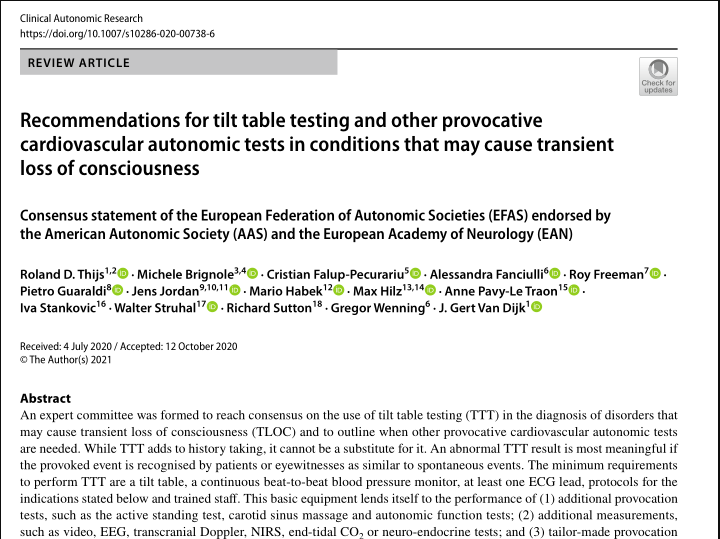Syncope
|
Recommendations for tilt table testing and other provocative cardiovascular autonomic tests in conditions that may cause transient loss of consciousness
Abstract An expert committee was formed to reach consensus on the use of tilt table testing (TTT) in the diagnosis of disorders that may cause transient loss of consciousness (TLOC) and to outline when other provocative cardiovascular autonomic tests are needed. While TTT adds to history taking, it cannot be a substitute for it. An abnormal TTT result is most meaningful if the provoked event is recognised by patients or eyewitnesses as similar to spontaneous events. The minimum requirements to perform TTT are a tilt table, a continuous beat-to-beat blood pressure monitor, at least one ECG lead, protocols for the indications stated below and trained staf. This basic equipment lends itself to the performance of (1) additional provocation tests, such as the active standing test, carotid sinus massage and autonomic function tests; (2) additional measurements, such as video, EEG, transcranial Doppler, NIRS, end-tidal CO2 or neuro-endocrine tests; and (3) tailor-made provocation procedures in those with a specifc and consistent trigger of TLOC. TTT and other provocative cardiovascular autonomic tests are indicated if the initial evaluation does not yield a defnite or highly likely diagnosis, but raises a suspicion of (1) refex syncope, (2) the three forms of orthostatic hypotension (OH), i.e. initial, classic and delayed OH, as well as delayed orthostatic blood pressure recovery, (3) postural orthostatic tachycardia syndrome or (4) psychogenic pseudosyncope. A therapeutic indication for TTT is to teach patients with refex syncope and OH to recognise hypotensive symptoms and to perform physical counter manoeuvres. 2021-04-02 |




